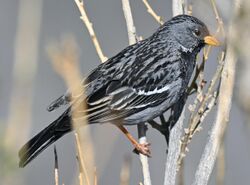Biology:Mourning sierra finch
| Mourning sierra finch | |
|---|---|

| |
| Male mourning sierra finch | |
| Scientific classification | |
| Domain: | Eukaryota |
| Kingdom: | Animalia |
| Phylum: | Chordata |
| Class: | Aves |
| Order: | Passeriformes |
| Family: | Thraupidae |
| Genus: | Rhopospina Cabanis, 1851 |
| Species: | R. fruticeti
|
| Binomial name | |
| Rhopospina fruticeti (Kittlitz, 1833)
| |

| |
| Synonyms | |
|
Fringilla fruticeti (protonym) | |
The mourning sierra finch (Rhopospina fruticeti) is a species of South American bird in the tanager family Thraupidae. It is the only member of the genus Rhopospina.
It is found in Argentina , Bolivia, Chile and Peru. It is a vagrant to the Falkland Islands and Brazil . Its natural habitats are subtropical or tropical dry shrubland and subtropical or tropical high-altitude shrubland.
Taxonomy
The mourning sierra finch was formally described and illustrated in 1883 by the German naturalist Heinrich von Kittlitz under the binomial name Fringilla fruticeti.[2] This species was formerly included in the genus Phrygilus.[3] A molecular phylogenetic study published in 2014 found that Phrygilus was polyphyletic,[4] and in the subsequent rearrangement, the mourning sierra finch was moved to the resurrected genus Rhopospina that had been introduced in 1851 by Jean Cabanis.[5][6] The genus name combines the Ancient Greek rhōps meaning "bush" with spina meaning "finch". The specific epithet is from the Latin fruticetum meaning "thicket".[7]
Three subspecies are recognised:[6]
- R. f. peruviana (Zimmer, JT, 1924) – Peru and west Bolivia
- R. f. coracina (Sclater, PL, 1891) – southwest Bolivia and northeast Chile
- R. f. fruticeti (Kittlitz, 1833) – north to south Chile and west Argentina
References
- ↑ BirdLife International (2018). "Rhopospina fruticeti". IUCN Red List of Threatened Species 2018: e.T22723080A132160426. doi:10.2305/IUCN.UK.2018-2.RLTS.T22723080A132160426.en. https://www.iucnredlist.org/species/22723080/132160426. Retrieved 13 November 2021.
- ↑ Kittlitz, Heinrich von (1833) (in German). Kupfertafeln zur Naturgeschichte der Vögel. Frankfurt am Main: Johann David Sauerländer. pp. 18-19, Plate 23 fig. 1. https://www.biodiversitylibrary.org/page/33042741.
- ↑ Paynter, Raymond A. Jr, ed (1970). Check-List of Birds of the World. 13. Cambridge, Massachusetts: Museum of Comparative Zoology. p. 105. https://www.biodiversitylibrary.org/page/14483340.
- ↑ Burns, K.J.; Shultz, A.J.; Title, P.O.; Mason, N.A.; Barker, F.K.; Klicka, J.; Lanyon, S.M.; Lovette, I.J. (2014). "Phylogenetics and diversification of tanagers (Passeriformes: Thraupidae), the largest radiation of Neotropical songbirds". Molecular Phylogenetics and Evolution 75: 41–77. doi:10.1016/j.ympev.2014.02.006. PMID 24583021. https://digitalcommons.lsu.edu/cgi/viewcontent.cgi?article=3613&context=biosci_pubs.
- ↑ Cabanis, Jean (1850–1851) (in German, Latin). Museum Heineanum : Verzeichniss der ornithologischen Sammlung des Oberamtmann Ferdinand Heine, auf Gut St. Burchard vor Halberstadt. 1. Halberstadt: R. Frantz. p. 135. https://www.biodiversitylibrary.org/page/49584514.
- ↑ 6.0 6.1 Gill, Frank; Donsker, David; Rasmussen, Pamela, eds (July 2020). "Tanagers and allies". IOC World Bird List Version 10.2. International Ornithologists' Union. https://www.worldbirdnames.org/bow/tanagers/.
- ↑ Jobling, James A. (2010). The Helm Dictionary of Scientific Bird Names. London: Christopher Helm. pp. 165, 335. ISBN 978-1-4081-2501-4.
External links
Wikidata ☰ Q1304677 entry


